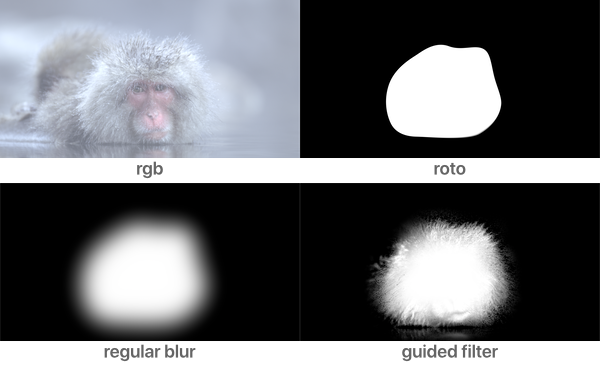The guided blur is an edge-preserving blur, useful to add fine details to a roto/matte. Similar to the 'Refine Edge' feature from Photoshop.
Guided Blur (Refine Edge)
First submitted: 25 January 2022
Author: Rafael Perez
Website: https://rafael.ai
Compatible Nuke versions: 11.0 or later
Compatibility: Linux, Mac, Windows
Guided Blur (Refine Edge)
The guided filter is an edge-preserving blur, useful to add details to the edges of a roto/matte using a second image as a guide.
For those who are familiar with Photoshop, the results are similar to the Refine Edge feature, improving fine detail around the edges.

Use cases
-
Improving edge detail from roto/mattes, especially with difficult to capture details like hair or fur.
-
Keying: blurring a core matte can lead to blobs/webbing around corners and small details. Blurring using the guided filter alleviates this problem.
How to use
- Connect the alpha/roto to the matte input and a RGB image which we will extract the details, usually the original plate, to the img input.
- Control the amount of detail using the edge detail slider.
Values close to 0 makes the filter behave like a regular blur.
Values higher than 6 are usually too high, identifying grain as edges and introducing artifacts.
Recommended values are between 2 and 5.
Release Notes
1.3
- Speed-up the gizmo by 30%
- Now compatible with Nuke 8
1.2
- Fixed error 'unknown command' when loading the gizmo using the function Other > All plugins > Update.
1.1
- Switched the image and input nodes, so it behaves more predictably when disabling the gizmo.
- Fixed error when using the gizmo with OCIO profiles
Credits
The filter was implemented following the technique proposed in the paper:
He, Kaiming, Jian Sun, and Xiaoou Tang. 'Guided image filtering.' In European conference on computer vision, pp. 1-14. Springer, Berlin, Heidelberg, 2010. kaiminghe.com/eccv10/
Questions or bugs,feel free to shoot me an email:
Rafael Silva - www.rafael.ai
Comments